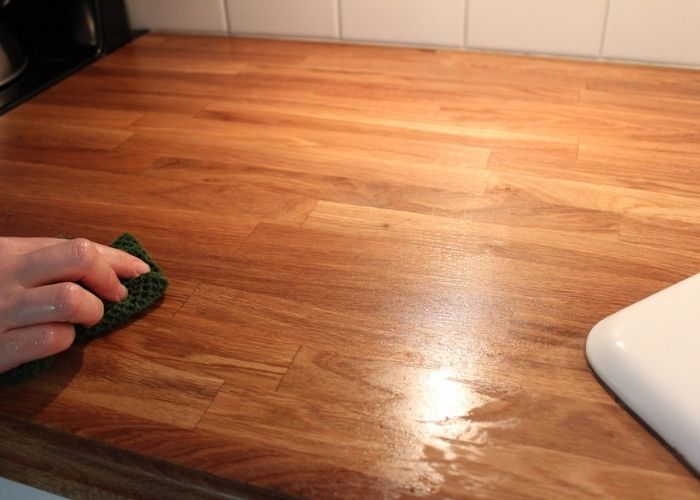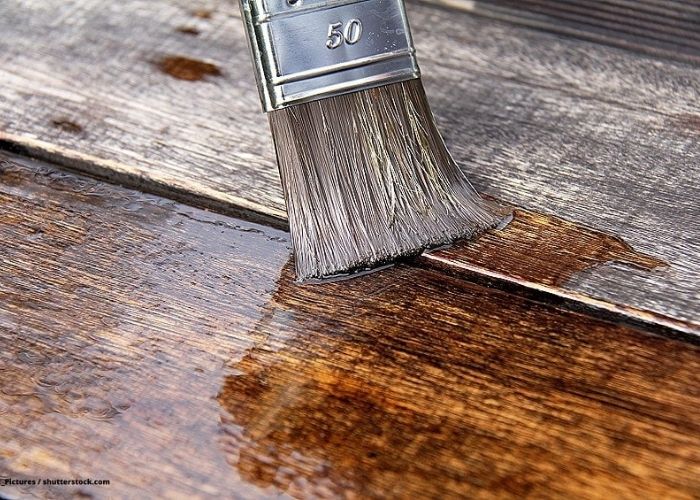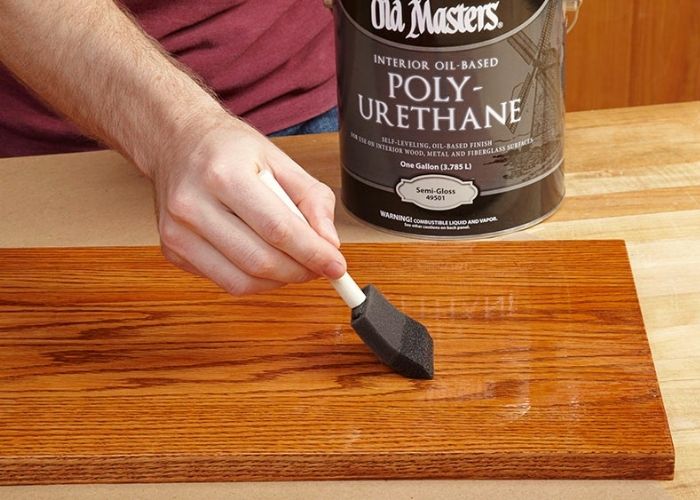You just finished applying the last coat of Tung oil on your wooden project, and it looks great. But, while it dries, is there more you can do for that surface? For example, can you put polyurethane over Tung oil?
The possibility of merging polyurethane and Tung oil on wood is fascinating, considering all the benefits the two products add to a surface.
Will polyurethane sit well on the oiled wood? Read along, and let’s clear the air about polyurethane varnish over oil.
Can You Put Polyurethane Over Tung Oil?
Yes! You can seal tung oil with polyurethane. Tung oil is a penetrative drying oil, but it doesn’t guarantee a durable waterproof finish. Applying polyurethane varnish over Tung oiled wood will protect the wood further against water damage, scratch, and discoloration.
The only condition is that the oiled wood must be completely dry, but it’s even better if it’s fully cured.
How Long Does Tung Oil Take to Dry and Cure?
The estimated drying time of Tung oil is around 24 to 72 hours to dry and a whole month, or more, to fully cure. In contrast, Tung oil finishes (oil and varnish blends) dries in 24 hours and need a week to cure completely.
Drying and curing times are dependent on the weather conditions. Low temperature with high humidity will slow down the drying process. High temperature with low atmospheric humidity will speed up Tung oil’s drying and curing process.
Does Tung Oil Even Need a Top Coat?
Yes, Tung oil needs a topcoat, especially on frequently used surfaces. The same way you put wipe on poly over boiled linseed oil is the same way you should do for tung oil.
Tung oil is a drying oil used for waterproofing wood and keeping it intact against other forms of damage.
It is often applied to natural wood to highlight the wood grain pattern. Although it’s been used for centuries as a final finish, its durability is no match for many varnish formulations or modern finishes.
And since Tung oil is receptive, you can clear coat it with just about any other protective finish to form a hard solid film surface.
Recommended read: How to thin polyurethane for wiping.
Can You Put Water-based Polyurethane Over Tung Oil?

Yes, you can put water-based polyurethane over Tung oil, just like you can polyurethane over old varnish.
However, you can only do this after it’s fully cured. If you’re wondering how a water-based finish will mix with Tung oil, well, it won’t. This is because you are layering, not mixing.
However, tung oil or polyurethane would work only by applying at least one coat of de-waxed shellac (sanding sealer) on the cured Tung oil wood surface. Once the shellac is dry, then you can finish the surface with a water-based polyurethane finish.
How to Apply Polyurethane over Tung Oil
Polyurethane offers myriad benefits to wood surfaces, especially those coated with Tung oil or linseed oil. Aside from the obvious –a tougher topcoat– polyurethane offers a variety of sheen options.
They include; matte, satin, semi-gloss, and high-gloss protective finish. Keep in mind that oil-based polyurethane has a yellowish tint and will definitely impact the color of the oiled wood over time.
First, test it on an inconspicuous spot. Then, if you like the new wood shades, proceed and apply it to the entire surface.
For purposes of this method, we’re using oil-based polyurethane over an already oiled wood surface. Whether the oiled surface is fresh or fairly used, this method works for both.
Here’s a list of what you will need for this process.
Tools and Materials
- Tung oil (Here’s our article on how to remove tung oil finish.)
- Oil-based polyurethane (Here’s our article on top oil-based polyurethane for hardwood floors.)
- Natural bristle brush or foam brush
- Sandpaper
- Sanding block or power sander
- Tack cloth
- Lint-free cloths
- Steel wool
Steps-By-Step Procedure for Applying Polyurethane Over Tung Oil
Step 1: Safety first
First, ensure your workstation is sufficiently ventilated, allowing for free airflow. You can also line the floor beneath using painter’s plastic to catch drips and spills.
Oil-based polyurethane emits strong fumes that can cause allergic reactions. That said, ensure you’re wearing gloves, a respirator mask, and safety goggles.
Step 2: Apply Tung oil
Here’s a quick preview of how to apply Tung oil if you’re starting with natural wood. First, sand it to smooth down any imperfections. Then, use 120- grit and finish with 150 to ensure the natural wood feels soft to the touch.
Use a power sander or sanding block depending on the surface size. Use a shop vacuum or collect the sanding dust. Go over the sanded surface once more with a tack cloth.
Spread a generous first coat of the oil using a natural bristle brush or foam brush. Let the oil soak into the porous surface for about 10 minutes. Then, wipe off the excess oil and let the surface dry fully; 24 to 72 hours depending on the type of Tung oil.
Ensure you layer two to three coats of Tung oil and ensure each prior coat is fully dry before reapplying Tung oil. After the final coat, let oiled wood dry for at least a week before you seal the Tung oil surface with a protective finish.
Recommended Reading: Will tung oil change the color of wood?
Step 3: Ensure the oiled wood surface is dry
How long has it been since you applied the last coat? A day, week, or months? Whether you applied pure Tung oil or the oil and varnish blends, ensure it is fully dried.
Check the dryness by pressing your pinky finger on an inconspicuous spot; wait for a day more if it’s soft or tacky. However, if the surface is firm and doesn’t take your fingerprint, proceed to the next step.
Step 4: Clean the oiled surface
Once you’re sure the Tung oil is dry, run a lint-free rag on the surface to remove any dust and bristles that may have settled on the surface. This applies to recently oiled wood.
However, if you have a fairly used Tung oiled surface, wash it with warm soapy water to eliminate debris. Let the wood dry out and assess its state. Is the surface evenly coated, or does it need at least one coat of Tung oil?
Step 5: Prep oil-based polyurethane finish
Gently open the can and stir the product using a stirring stick or any clean stick. Stir polyurethane in one direction, reaching the bottom and coming up to mix pigment and solvent that may have separated while on the shelf.
Shaking the oil-based finish is not one of the ways of mixing the product: not unless the product is in an aerosol can. Shaking polyurethane will create bubbles and ruin your topcoat finish.
Of course, you may sand polyurethane bubbles off the surface; but why go there when you can avoid it altogether?
Pour a bit of the finish onto a separate stain bowl. It’s always a good idea to avoid applying the finish of the can –you may introduce impurities that will spoil polyurethane prematurely.
We recommend thinning the first two coats in the ratio of three parts polyurethane to one part thinner –mineral spirits. This is guaranteed to give you a professional-looking finish.
Step 6: Apply the first coat of polyurethane

Dip your poly brush in the finish and apply a thin coat of polyurethane. Brush the product in long strokes along the wood grain. Go over every inch of your wooden project and ensure you coat the entire surface evenly.
If you’re using wipe-on poly, apply a light layer using a lint-free cloth or a fine grit scrub sponge. (Also, find out the best way to apply wipe-on poly)
Step 7: Wait for polyurethane to dry
The secret to the seamless layering of finishes on wood lies in the drying period. Let the polyurethane dry overnight or 24 hours before applying the following coat. Then, apply at least three coats of polyurethane for more durability.
Step 8: Sand and clean the polyurethane layer
Sand the dried polyurethane surface using a fine-grit sandpaper-220 grit or super fine steel wool. Gently rub the surface to create a base for the next coat; wipe the dust using a soft rag.
Recommended Reading: Does polyurethane protect wood from water?
Step 9: Repeat steps 6-8 for the second coat
Reapply the oil finish, allow sufficient time for polyurethane to dry, scuff, and wipe off the dust. Note that you still use the finish we thinned earlier for this second coat.
Step 10: Apply the final coat of oil-based finish and let it cure
Do not thin the final coat, and don’t sand it either. Brush or wipe it on, let the finished surface dry, and cure for as long as possible. It could take approximately three weeks to one month or even more. (Here’s an article on brush-on poly versus wipe-on poly that will help you make a decision on what to use.)
Oil-based polyurethane off-gases a lot while it cures.
Try to keep yourself and your household safe from the effects of toxic polyurethane fumes. Clean up your workstation and brushes.
Clean or dispose of shop rags appropriately. Read our article for storage tips to extend the lifespan of opened polyurethane cans.
See Also: Can You Use Tung Oil Over Water-based Stain?
FAQs
What finish can be applied over Tung oil?
You can seal dried Tung oil with finishes like wipe-on poly or spar varnish, shellac, lacquer, and even wax –carnauba wax or beeswax. Choose a finish that will provide the best protection based on the intended function of the Tung oiled surface. Remember, you can only apply the chosen finish once the oiled surface is fully cured. Now, find out whether it’s okay to polyurethane over furniture wax.
How do you apply polyurethane over Tung oil?
- Ensure the oiled wood surface is dry
- Clean the oiled surface
- Prep oil-based polyurethane finish
- Apply the first coat of polyurethane
- Wait for polyurethane to dry (Check “how long for polyurethane to dry” post if you’re not sure)
- Sand and clean polyurethane layer
- Repeat steps 6-8 for the second coat
- Apply the final coat of oil-based finish and let it cure
How long does Tung oil need to dry before applying polyurethane?
If you used 100% pure Tung oil product, you might need to wait up to a week before applying polyurethane. However, if you used a Tung oil finish (polymerized Tung oil), wait 24 hours before finishing with poly.
Read also: Can I apply polyurethane over polycrylic?
Final Thoughts
So, can you put polyurethane over Tung oil? Yes, you can. However, ensure the Tung oil surface is completely hardened before applying polyurethane.
Tung oil makes wood waterproof and scratchproof to a certain degree. Polyurethane provides absolute water and scratch resistance. Coating wood with both products will guarantee a prolonged lifespan plus a desirable sheen.
We’d love to hear about your experiences with applying poly over Tung oil. Talk to us in the comments section below.

